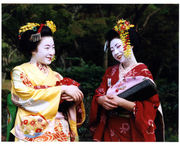通訳案内士(通訳ガイド)試験受験対策<2008年度英語第2次試験の模範解答例(その1)>
現行の通訳案内士試験は、2006年4月に国交省より発表されました<通訳案内士試験ガイドライン>に沿って出題、実施されています。
http://
今年、第2次試験を受験する受験者は、2006年度から2011年度までの試験内容(時間帯別問題群)をよく知っておくことが重要です。
本日は、2008年度英語第2次試験の下記時間帯別問題群と模範解答例を提示させていただきます。
問題群(1)[ 9:00〜10:00]
問題群(2)[10:00〜12:00]
●例年通り、最初に、受験者の氏名と住所を質問されました。
Please tell us your name and where you live.
2008年度は、日本語による質疑応答はなく、代わりに、英語で「通訳ガイドになりたい動機」を問われました。
●何故、あなたは通訳ガイドになりたいのですか?
Why do you want to be a tour guide?
毎年、同じような質問が繰り返し出題されています。
受験者は、自分が言いやすい文型、内容に組み替えて準備しておくことが重要です。
英語以外の外国語での受験者は、その外国語に置き換えて準備してください。
━━━━━━━━━━━━━━━━━━━━━━━━━━━━
2008年度英語第2次試験の時間帯別問題群(1)(2)と模範解答例
━━━━━━━━━━━━━━━━━━━━━━━━━━━━
●問題群(1)[9:00〜10:00]
(1)温泉を推薦して欲しい。
I heard there are many hot springs in Japan. Please recommend one of them.
?If you are staying in Tokyo, I would recommend Hakone hot-spring resort. Hakone is a popular all-year tourist site because of its many hot-spring resorts, beautiful scenery and comfortable climate. Its easy access from Tokyo, views of Mt. Fuji, and the plentiful facilities in the district also add to its attraction.
?If you are staying in Kyoto or any other place in the Kansai area, I would recommend Arima hot-spring resort in Hyogo Prefecture. Located, quite conveniently, within the city limits of Kobe, this resort attracts numerous visitors throughout the year. With a history of over 1,000 years, it is said to be one of the three oldest hot-spring resorts in Japan. Although Arima Onsen basically has a modern face today, one can still find several old buildings and some nice temples when strolling through the narrow streets of the town center. Due to its compact size, Arima resort can be explored entirely on foot.
?If you are staying in Kyushu, I would recommend Beppu hot-spring resort in Oita Prefecture. One of the most popular resorts in all of Japan, Beppu provides more than 3,000 sources of hot water not only to the hotels and inns but also to private homes. Beppu has the sea in the foreground and mountains to its rear. This location and the variety of hot mineral springs make it a favorite vacation spot for travelers.
(2)最近地球温暖化が深刻であるが、日本はどうすればよいのか。
These days, global warming is getting more serious. How does it affect Japan? What can Japan do to stop global warming?
As with everywhere else on Earth, global warming has been affecting Japan more seriously than before. For example, it has gradually increased torrential rainfalls, decreased agricultural water, changed the flora, and eroded some beaches. More and more people are realizing that global warming is a real threat to our lives. I think we all should start conserving much more energy, and the Japanese government should redouble its efforts to tackle global warming domestically, as well as internationally.
(3)明治維新は何故重要か、何をもたらしたか。
I heard the Meiji Restoration was very important in Japanese history. Why was it so important? Tell me how it happened and what changes it brought to Japan?
Japan realized the need to establish a modern state to cope with powerful Western countries, once it opened its doors to the world in 1854 after 220 years of national isolation. As a result of strong demands from imperial loyalists of the lower samurai class, the last shogun Tokugawa Yoshinobu stepped down in 1867, and Emperor Meiji came to the throne. Thus, the Meiji Restoration took place in 1868, which included a series of drastic political, economic and cultural changes. Seeking to “enrich the nation and strengthen the military,” the new government promoted industrialization and modernization, through abolishing the feudal system and introducing Western culture and political systems.
(4)相撲取りが塩をまき、しこを踏む理由は何か。
I saw sumo wrestlers throw salt into the ring and stomp their feet before their match. Why do they do that?
Sumo is a time-honored sport, and, historically, it was done as part of a Shinto ritual as well. Purification rites are a vital part of Shinto, and, in Japan, salt is believed to have the sacred power to purify the impure. This is why sumo wrestlers throw salt into the ring in order to purify their sacred fighting ground before their match. Also, they stomp their feet so that they can ward off or placate evil spirits hidden in the earth of the ring.
(5)大名行列を説明せよ。
I heard that there was “the procession of feudal lords” in the Edo period. Please explain what it was like and what it was for?
During the Edo period, there was a rule of the Tokugawa shogunate called “Sankin-kotai,” or the alternate attendance system. By this rule, daimyo, or feudal lords, were required to reside in alternate years in Edo (now Tokyo) to be in attendance of the shogun. A typical daimyo traveled to the capital, with 150 to 300 or more vassals and members of his household, using the main highways. This was called “daimyo-gyoretsu,” or “the procession of feudal lords.” The size of the entourage was an indication of the daimyo’s status. The journeys and the overall upkeep of a daimyo’s Edo estates consumed a large part of his income, so they financially weakened the daimyo and thus the Tokugawa shogunate was better able to control them.
(6)あなたの好きなテレビ番組は何か。外国人にお奨めのテレビ番組は何か。
What kinds of TV programs do you like? What TV program would you recommend to foreigners?
Of the wide variety of programs that are popular on Japanese TV, I personally like documentaries the most. But, since most foreign visitors may not understand Japanese, I would recommend they watch samurai dramas. By watching them, they can get a very good idea of what the traditional Japanese lifestyle was like, even if they don’t understand the language.
(7)何故、あなたは通訳ガイドになりたいのですか?
Why do you want to be a tour guide?
●問題群(1)[10:00〜12:00]
(1)鎌倉には何故お寺が多いのか。
Why are there so many Buddhist temples in Kamakura?
During the Kamakura period, when Japan saw the rise of the samurai to power, several new Buddhist sects were established in Japan. Among these sects, the Rinzai sect came to enjoy the patronage of the upper warrior class, especially “shikken,” or Hojo regents. Hojo regents financially helped to build many large temples in Kamakura. This is why there are many temples in Kamakura.
(2)日本の気候を説明せよ。
What is Japan’s climate like?
There are four distinct seasons in Japan — spring, summer, fall and winter. There is also a rainy season between spring and summer. Japan’s climate is influenced by summer and winter monsoons, ocean currents and topographical features.
(3)日本人は何故おめでたい折に鯛を食べるのか。
Why do Japanese people eat sea bream on happy occasions?
On festive occasions such as wedding banquets, Japanese people eat sea bream, often complete with its head and tail. It is because “tai,” the Japanese word for sea bream, sounds similar to, thus is associated with, a Japanese word “medetai,” meaning “auspicious.” Also, sea bream is red, and the color of red has traditionally been the color of celebration in Japan because it is associated with the sun.
(4)日本の木造建築の利点を説明せよ。
I hear that many Japanese houses are made of wood. What are the advantages of wooden structures in Japan?
Earthquakes are relatively frequent in Japan, and wooden houses are better at withstanding minor quakes. When wood is subjected to a force it may bend and warp, but it does not break easily. And when the force is removed, the wood returns to its former shape. Because wood is flexible, it can absorb seismic stresses. Also, Japan’s summer is hot and humid, but wood breathes and absorbs moisture. In severe cold winters, wood is not as cold to touch as stone.
(5)参勤交代の目的を説明せよ。
In the Edo period, there was a system called “Sankin-Kotai.” What was the purpose of it?
The “sankin-kotai” system is known as the system of “alternate attendance.” It was instituted by the third shogun of the Tokugawa shogunate, Iemitsu, as a means of political control. During the Edo period, Japan was divided into many autonomous feudal domains. Each lord, however, had to stay in Edo (modern-day Tokyo) every other year. Members of his family were held in Edo as hostages. One of the chief objectives of this system was to weaken the lords financially.
(6)総理大臣はどのように選出されるのか。
How is Japan’s prime minister elected?
The Japanese prime minister is elected by the Diet from among its own members. Japan has a similar system to the UK’s parliamentary cabinet system, and its government is party-based. So the leader of the majority party is usually appointed prime minister.
(7)何故、あなたは通訳ガイドになりたいのですか?
Why do you want to be a tour guide?
━━━━━━━━━━━━━━━━
●<ハローの合格必勝教材>のお申込み:
http://
━━━━━━━━━━━━━━━━
現行の通訳案内士試験は、2006年4月に国交省より発表されました<通訳案内士試験ガイドライン>に沿って出題、実施されています。
http://
今年、第2次試験を受験する受験者は、2006年度から2011年度までの試験内容(時間帯別問題群)をよく知っておくことが重要です。
本日は、2008年度英語第2次試験の下記時間帯別問題群と模範解答例を提示させていただきます。
問題群(1)[ 9:00〜10:00]
問題群(2)[10:00〜12:00]
●例年通り、最初に、受験者の氏名と住所を質問されました。
Please tell us your name and where you live.
2008年度は、日本語による質疑応答はなく、代わりに、英語で「通訳ガイドになりたい動機」を問われました。
●何故、あなたは通訳ガイドになりたいのですか?
Why do you want to be a tour guide?
毎年、同じような質問が繰り返し出題されています。
受験者は、自分が言いやすい文型、内容に組み替えて準備しておくことが重要です。
英語以外の外国語での受験者は、その外国語に置き換えて準備してください。
━━━━━━━━━━━━━━━━━━━━━━━━━━━━
2008年度英語第2次試験の時間帯別問題群(1)(2)と模範解答例
━━━━━━━━━━━━━━━━━━━━━━━━━━━━
●問題群(1)[9:00〜10:00]
(1)温泉を推薦して欲しい。
I heard there are many hot springs in Japan. Please recommend one of them.
?If you are staying in Tokyo, I would recommend Hakone hot-spring resort. Hakone is a popular all-year tourist site because of its many hot-spring resorts, beautiful scenery and comfortable climate. Its easy access from Tokyo, views of Mt. Fuji, and the plentiful facilities in the district also add to its attraction.
?If you are staying in Kyoto or any other place in the Kansai area, I would recommend Arima hot-spring resort in Hyogo Prefecture. Located, quite conveniently, within the city limits of Kobe, this resort attracts numerous visitors throughout the year. With a history of over 1,000 years, it is said to be one of the three oldest hot-spring resorts in Japan. Although Arima Onsen basically has a modern face today, one can still find several old buildings and some nice temples when strolling through the narrow streets of the town center. Due to its compact size, Arima resort can be explored entirely on foot.
?If you are staying in Kyushu, I would recommend Beppu hot-spring resort in Oita Prefecture. One of the most popular resorts in all of Japan, Beppu provides more than 3,000 sources of hot water not only to the hotels and inns but also to private homes. Beppu has the sea in the foreground and mountains to its rear. This location and the variety of hot mineral springs make it a favorite vacation spot for travelers.
(2)最近地球温暖化が深刻であるが、日本はどうすればよいのか。
These days, global warming is getting more serious. How does it affect Japan? What can Japan do to stop global warming?
As with everywhere else on Earth, global warming has been affecting Japan more seriously than before. For example, it has gradually increased torrential rainfalls, decreased agricultural water, changed the flora, and eroded some beaches. More and more people are realizing that global warming is a real threat to our lives. I think we all should start conserving much more energy, and the Japanese government should redouble its efforts to tackle global warming domestically, as well as internationally.
(3)明治維新は何故重要か、何をもたらしたか。
I heard the Meiji Restoration was very important in Japanese history. Why was it so important? Tell me how it happened and what changes it brought to Japan?
Japan realized the need to establish a modern state to cope with powerful Western countries, once it opened its doors to the world in 1854 after 220 years of national isolation. As a result of strong demands from imperial loyalists of the lower samurai class, the last shogun Tokugawa Yoshinobu stepped down in 1867, and Emperor Meiji came to the throne. Thus, the Meiji Restoration took place in 1868, which included a series of drastic political, economic and cultural changes. Seeking to “enrich the nation and strengthen the military,” the new government promoted industrialization and modernization, through abolishing the feudal system and introducing Western culture and political systems.
(4)相撲取りが塩をまき、しこを踏む理由は何か。
I saw sumo wrestlers throw salt into the ring and stomp their feet before their match. Why do they do that?
Sumo is a time-honored sport, and, historically, it was done as part of a Shinto ritual as well. Purification rites are a vital part of Shinto, and, in Japan, salt is believed to have the sacred power to purify the impure. This is why sumo wrestlers throw salt into the ring in order to purify their sacred fighting ground before their match. Also, they stomp their feet so that they can ward off or placate evil spirits hidden in the earth of the ring.
(5)大名行列を説明せよ。
I heard that there was “the procession of feudal lords” in the Edo period. Please explain what it was like and what it was for?
During the Edo period, there was a rule of the Tokugawa shogunate called “Sankin-kotai,” or the alternate attendance system. By this rule, daimyo, or feudal lords, were required to reside in alternate years in Edo (now Tokyo) to be in attendance of the shogun. A typical daimyo traveled to the capital, with 150 to 300 or more vassals and members of his household, using the main highways. This was called “daimyo-gyoretsu,” or “the procession of feudal lords.” The size of the entourage was an indication of the daimyo’s status. The journeys and the overall upkeep of a daimyo’s Edo estates consumed a large part of his income, so they financially weakened the daimyo and thus the Tokugawa shogunate was better able to control them.
(6)あなたの好きなテレビ番組は何か。外国人にお奨めのテレビ番組は何か。
What kinds of TV programs do you like? What TV program would you recommend to foreigners?
Of the wide variety of programs that are popular on Japanese TV, I personally like documentaries the most. But, since most foreign visitors may not understand Japanese, I would recommend they watch samurai dramas. By watching them, they can get a very good idea of what the traditional Japanese lifestyle was like, even if they don’t understand the language.
(7)何故、あなたは通訳ガイドになりたいのですか?
Why do you want to be a tour guide?
●問題群(1)[10:00〜12:00]
(1)鎌倉には何故お寺が多いのか。
Why are there so many Buddhist temples in Kamakura?
During the Kamakura period, when Japan saw the rise of the samurai to power, several new Buddhist sects were established in Japan. Among these sects, the Rinzai sect came to enjoy the patronage of the upper warrior class, especially “shikken,” or Hojo regents. Hojo regents financially helped to build many large temples in Kamakura. This is why there are many temples in Kamakura.
(2)日本の気候を説明せよ。
What is Japan’s climate like?
There are four distinct seasons in Japan — spring, summer, fall and winter. There is also a rainy season between spring and summer. Japan’s climate is influenced by summer and winter monsoons, ocean currents and topographical features.
(3)日本人は何故おめでたい折に鯛を食べるのか。
Why do Japanese people eat sea bream on happy occasions?
On festive occasions such as wedding banquets, Japanese people eat sea bream, often complete with its head and tail. It is because “tai,” the Japanese word for sea bream, sounds similar to, thus is associated with, a Japanese word “medetai,” meaning “auspicious.” Also, sea bream is red, and the color of red has traditionally been the color of celebration in Japan because it is associated with the sun.
(4)日本の木造建築の利点を説明せよ。
I hear that many Japanese houses are made of wood. What are the advantages of wooden structures in Japan?
Earthquakes are relatively frequent in Japan, and wooden houses are better at withstanding minor quakes. When wood is subjected to a force it may bend and warp, but it does not break easily. And when the force is removed, the wood returns to its former shape. Because wood is flexible, it can absorb seismic stresses. Also, Japan’s summer is hot and humid, but wood breathes and absorbs moisture. In severe cold winters, wood is not as cold to touch as stone.
(5)参勤交代の目的を説明せよ。
In the Edo period, there was a system called “Sankin-Kotai.” What was the purpose of it?
The “sankin-kotai” system is known as the system of “alternate attendance.” It was instituted by the third shogun of the Tokugawa shogunate, Iemitsu, as a means of political control. During the Edo period, Japan was divided into many autonomous feudal domains. Each lord, however, had to stay in Edo (modern-day Tokyo) every other year. Members of his family were held in Edo as hostages. One of the chief objectives of this system was to weaken the lords financially.
(6)総理大臣はどのように選出されるのか。
How is Japan’s prime minister elected?
The Japanese prime minister is elected by the Diet from among its own members. Japan has a similar system to the UK’s parliamentary cabinet system, and its government is party-based. So the leader of the majority party is usually appointed prime minister.
(7)何故、あなたは通訳ガイドになりたいのですか?
Why do you want to be a tour guide?
━━━━━━━━━━━━━━━━
●<ハローの合格必勝教材>のお申込み:
http://
━━━━━━━━━━━━━━━━
|
|
|
|
|
|
|
|
通訳案内士は民間外交官! 更新情報
-
最新のアンケート
























